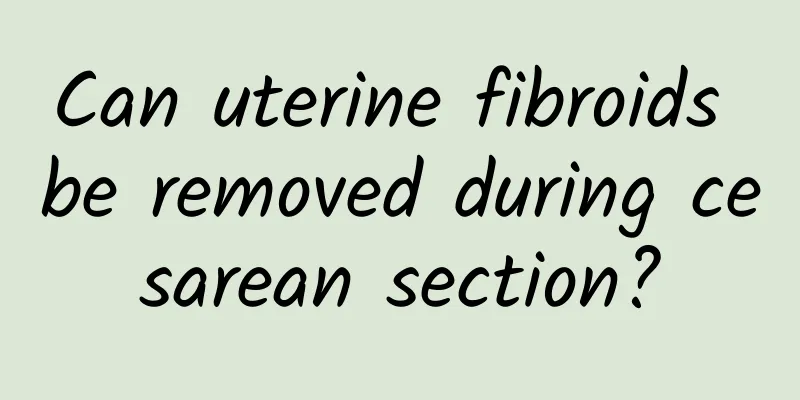Can uterine fibroids be removed during cesarean section?

|
Pregnant women with uterine fibroids hope to have the fibroids removed at the same time during a caesarean section. However, this idea is generally not recognized by doctors because the caesarean section itself will have a certain impact on the health of the pregnant woman. The impact may be greater if a uterine fibroid surgery is performed at this time. Therefore, this is generally not done. Interaction between pregnancy and fibroids The impact of pregnancy and fibroids is mutual, and this concept is very easy to understand. After pregnancy, fibroids may increase in size, enlarged fibroids may degenerate, and pedunculated fibroids may twist, etc. But don’t all fibroids get bigger after pregnancy? A large number of research reports show that except for the early stage fibroids that are increasing in size, many fibroids remain unchanged in the middle and late stages. Basically, they are almost constant or even shrink in the middle and late stages. If there is no intervention, 79% of the fibroids will become smaller during postoperative follow-up. The impact of fibroids on pregnancy depends on the number, location, and size of the fibroids. Fibroids can cause malposition of the fetus during pregnancy. Fibroids in the lower segment during delivery affect the patency of the birth canal and may require a cesarean section. Fibroids in other parts of the body do not necessarily require a cesarean section. After delivery, they affect the contraction of the uterus and may cause postpartum hemorrhage. Can all fibroids be removed? Common conditions suitable for fibroid removal are: subserosal fibroids (especially fibroids with ligaments); intramural fibroids that protrude outward; fibroids <6cm; fibroids in the lower uterine segment that affect fetal delivery and incision suture; and pedunculated submucosal fibroids. Pelvic and intrauterine infections must be excluded, blood supply must be guaranteed, there must be good technical support (such as uterine artery embolization, hysterectomy technology, etc.), the mother must have no serious comorbidities and complications, and her vital signs must be stable. In what situations is it not suitable to remove fibroids? It is necessary to be selective when performing cesarean section and removing fibroids at the same time. The following situations require extreme caution and are not recommended for removal: 1. Myomas at the fundus of the uterus near the opening of the fallopian tube and myomas at the horns of the uterus. Long-term follow-up has found that they damage the fallopian tubes and the pregnancy rate drops by 40% to 60%. The horns of the uterus are rich in blood vessels and bleed a lot. 2. Broad ligament myomas (the uterus is rich in arteries and veins, and the blood vessels rupture and bleed a lot, making it difficult to stop bleeding and easily damaging the ureter. 3. Myomas in the body and bottom of the uterine cavity that protrude into the uterine cavity are prone to infection and affect wound healing. 4. Huge myomas at the cervix of the uterus are not easy to expose and are prone to damage nearby organs. 5. Intrauterine infection and pelvic infection exist. 6. Severe diseases, the operation time should not be too long (such as severe heart disease, hypertension, etc.); 7. Those who already have weak uterine contractions and heavy bleeding. In these cases, rashly removing myomas often puts obstetricians in a difficult position, and may cause heavy bleeding and hysterectomy. There have been cases of maternal death as a result. Problems with myomectomy: Some patients with uterine fibroids underwent laparoscopic myomectomy and became pregnant later. Intra-abdominal bleeding and uterine scar rupture occur in the middle and late stages of pregnancy. More and more cases are being reported. There are also reports of uterine rupture during subsequent pregnancies, as fibroids were removed during cesarean sections, resulting in multiple uterine scars. Therefore, women who wish to have another child should be cautious when removing fibroids. The safety of uterine myomectomy during cesarean section is an important issue, but there is a lack of good evidence-based evidence. This is because the existing literature reports have small data, relatively simple sample sources, and insufficient retrospective analysis. There is a lack of prospective large-sample studies on whether to remove myomas during cesarean section or not, and there is a lack of high-quality MATA analysis articles. Whether to remove the fibroids depends not only on the above-mentioned indications, but also on the doctor's incision selection, suturing techniques and hemostasis techniques. The comprehensive conditions of the hospital and blood supply guarantee must also be considered. |
<<: What are the symptoms of Down syndrome?
>>: Thickness detection of cesarean section scars for second child
Recommend
What are the four properties and five flavors of traditional Chinese medicine?
In fact, the food we often talk about in life all...
What foods are the fastest for diuresis? These foods can remove dampness and promote diuresis
Everyone knows that fruits have many benefits for...
What causes leg pain and numbness?
Generally speaking, leg pain and foot numbness ar...
What to eat in late pregnancy to promote uterine contractions
We all know that uterine contractions in women ar...
What to do if you have back pain after confinement
Confinement is a process that most Asian women wi...
What can Astragalus be soaked in water with?
As we all know, Scutellaria baicalensis is a Chin...
What are some good ways to self-diagnose bad breath?
Sometimes you have bad breath but don't notic...
Muscle twitching under the eyes
Muscle twitching under the eyes is the main sympt...
What should I do if my ears itch?
Many people often experience itchy ears, which ma...
How to treat peeling feet
Although foot peeling is not a major disease prob...
What to do if your eyes hurt due to electric shock
When people are welding, the arc light generated ...
Does ceftriaxone treat rhinitis?
Cephalexin is an anti-inflammatory drug that is w...
What to do if you keep suffering from insomnia
Insomnia is very harmful to human health. If you ...
Warts at the base of the penis
Because of the privacy of the private parts, many...
Does taking folic acid cause nausea?
It is also a nutrient necessary for the growth an...









